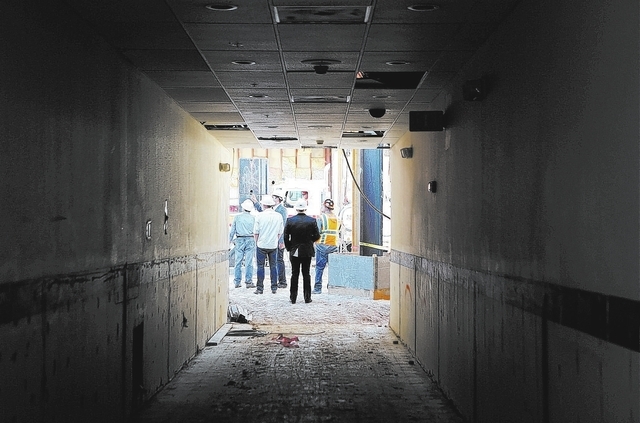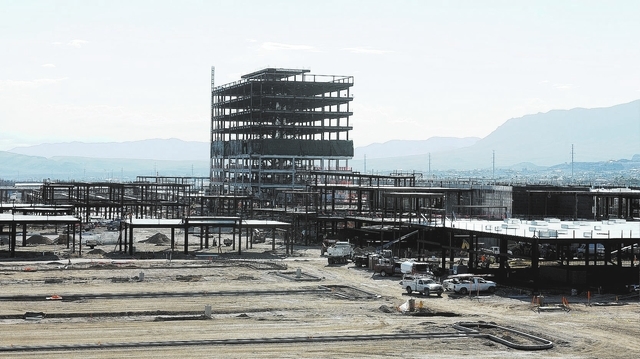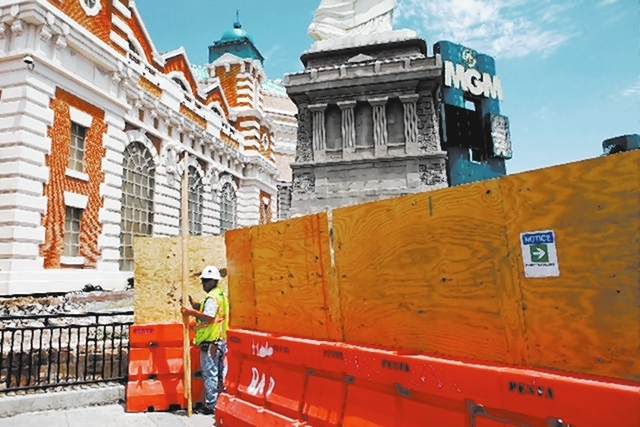Las Vegas construction poised to prosper in 2014
Southern Nevada’s construction sector is set to keep building itself back up in 2014.
Thanks to a passel of resort, residential and commercial projects, the industry’s fortunes are on the upswing, though business will remain soft compared with the Las Vegas Valley’s boom years in 2005 and 2006.
“We’re really optimistic for next year. We’re actually seeing things head in a positive direction,” said John Cannito, chief operating officer of Penta Building Group.
To see why construction is looking up in 2014, start with what happened in 2013.
The recession may have devastated Southern Nevada’s construction industry, but 2013 brought the first real glimmer of recovery. From new projects breaking ground to long-dormant developments finding new life, it was a year of growth.
“We’ve seen a lot more opportunities than we’ve seen in the past. The market is still very competitive, but there is a lot more work available than there used to be. It’s getting better,” Cannito said.
It’s getting better after falling to devastating lows, said Steve Brown, director of the University of Nevada, Las Vegas’ Center for Business and Economic Research. The Las Vegas Valley had roughly 112,000 construction jobs at its 2006 peak, the Department of Employment, Training and Rehabilitation reports. That dropped to just less than 35,000 in 2012, but had climbed back to more than 38,000 by October, still well below prerecession levels.
Or consider housing construction. Builders routinely closed on 35,000 units a year in Southern Nevada during the boom. That fell to 5,389 closings in 2012, according to local housing research firm SalesTraq. In 2013, builders blew past their 2012 total by September, closing on 5,541 units in the first nine months of the year. So it’s an improvement, but still well off of boom-era highs.
“We’ve actually seen quite an increase in construction activity in percentage terms, but we’re starting from such a low base compared to our historical norms that we’re still scraping along, not that far from the bottom,” Brown said.
Some of 2013’s strides will carry over into 2014, and there’ll be new projects breaking ground to boot.
Perhaps the biggest 2013 project continuing into the New Year is SBE Entertainment’s remake of the Sahara into SLS Las Vegas. SBE is in the middle of a $415 million remodel that will wrap in the fall with 1,600 rooms, nearly a dozen restaurants and clubs and a 60,000-square-foot casino.
Work is also continuing at Caesars Entertainment Corp.’s $550 million Linq, and at its $185 million rehab of the former Bill’s Gamblin’ Hall. MGM Resorts International is investing $100 million in an outdoor plaza and pedestrian mall between New York-New York and Monte Carlo — a gateway to the 20,000-seat arena the company plans to build with AEG. MGM Resorts is also renovating the facades of the two resorts.
Also, Juno Property Group announced plans for the $50 million, 60,000-square-foot Grand Bazaar Shops near the entrance of Bally’s. The project is scheduled to open in the fall.
And everyone is waiting for the possible startup of Genting Group’s Resorts World Las Vegas, which is supposed to get underway in 2014 on the site of the former Stardust and Echelon. Genting executives have said they’ll invest from $2 billion to $7 billion in the megaresort.
Builders have been busy off-Strip, as well.
After a hiatus of nearly five years, construction restarted on The Shops at Summerlin, a 106-acre, 1.6 million-square-foot regional retail center at Sahara Avenue and the 215 Beltway.
Another victim of the recession, The LandWell Co.’s Cadence master plan in Henderson, is set to see its first homes under construction in 2014. The 2,200-acre, 13,000-home project stalled after former development partner Centex slashed its market presence and merged with Pulte Homes in the downturn.
Plus, once-bankrupt Henderson master plan Inspirada is poised to make a comeback, said Nat Hodgson, executive director of the Southern Nevada Home Builders Association. The 2,000-acre property went bankrupt in 2009, but today, KB Home owns most of it and has been outlining plans for parks to serve its 8,500 homes.
Homebuilders have also bought up parcels for subdivisions outside master plans. Ryland Homes just closed on 38 acres between Buffalo and Durango drives north of the 215 Beltway in southwest Las Vegas. DR Horton recently bought 38.1 acres at Starr Avenue and Las Vegas Boulevard South. And North Las Vegas’ stalled Park Highlands master plan finally has new owners: KBS Strategic Opportunity REIT JV recently spent $20 million to finish putting together a 1,670-acre swath of land at the site.
But some roadblocks may stand in the way of the building sector making bigger strides in 2014.
For starters, much of the potential residential development would merely replace big projects that wind down, Hodgson said. After about a decade in development, for example, Anthem Highlands in Henderson is wrapping up.
“Everybody’s concentrating on replacement, not growth. We’re still in that mode,” Hodgson said. “I think we’re going to be pretty steady. I think we’ll duplicate 2013’s numbers. We had a good year in construction starts, and we’re looking pretty good to at least stay the same next year. And I haven’t been able to say that in years.”
If 2014 brings big gains in local housing hiring, it would be likelier to happen among strategic workers, such as marketing directors or land-acquisition professionals, Hodgson said. That’s because most builders downsized local administrative operations and consolidated management jobs within regional headquarters during the recession. As conditions improve here, builders could find themselves needing more locally based executives, Hodgson said.
On a broader scale, visitor volume in Southern Nevada was flat from 2012 to 2013, Brown said, and that could make it hard to justify new construction on the Strip. And because the Strip drives the rest of the economy, that could have implications downstream, in other construction submarkets.
“If we look at patterns of national spending on entertainment, hotels and accommodations, the American consumer wasn’t that aggressive in 2013,” Brown said. “We would need to see more consumer spending and convention traffic in 2014 and 2015 to really make people think it’s time to build another big property on the Strip.”
Off-Strip, and despite a few recent big land deals, residential builders are having trouble finding big blocks of developable land, and that could pinch gains in new-home construction, Brown said.
There’s also still a sizable gap between the price of a new home and a resale. SalesTraq figures showed a September median price of $267,856 for a new home, and $154,995 for a resale. That difference leaves less impetus to build, because buyers can snap up existing homes at an affordable price, Brown said.
So expect residential construction to increase, but at a slower pace than in 2013, he said. Rather than seeing new-home permits soar 30 percent, look for a 10 percent gain.
On the commercial side, local economic development officials say a number of national companies are weighing expanding into Las Vegas, Brown said. Some of those businesses want as much as 1 million square feet of space — a product type that just doesn’t exist here. Their options are to build space to suit, or skip Las Vegas and go instead to a market that can meet their demands immediately. And with relatively weak business investment in buildings nationwide, it’s too early to tell which way they might go, Brown said.
Put it all together, and Brown said he expects about a 5 percent gain in local construction jobs in 2014.
The state employment department doesn’t forecast local construction jobs, but the agency predicts statewide job growth of about 9 percent, chief economist Bill Anderson said. The industry should end 2014 with about 64,400 jobs, up from 59,300 now, though down from 146,000 in 2006.
For Penta, at least, 2014 should be a brisk hiring year, Cannito said.
“Realistically, as long as there are people willing to invest in construction — and it seems like more are willing to invest — then we should see construction moving forward,” he said.
Cannito said he expects the market to improve enough to let Penta add about 10 percent in 2014 to its workforce of 140. It’ll help that the company, along with Hunt Construction Group, just landed the $350 million contract to build MGM Resorts’ planned arena.
“We expect to see a good bit of new, ground-up construction, but we’ll probably mostly see renovations and tenant improvements,” Cannito said. “There are still a lot of renovations that need to be done on hotels, and still a lot of properties where people can take advantage of refreshing things. We see more of a sustained growth, with the market coming back but not spiking the way it did in the 2000s.”
Contact reporter Jennifer Robison at jrobison@reviewjournal.com. Follow @J_Robison1 on Twitter.





















